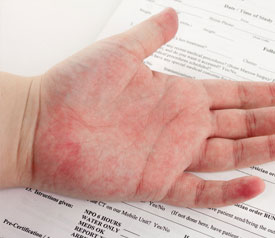
Latex allergies have long been an issue in the medical community. Patients and medical professionals alike can be exposed to the ingredients of latex multiple times a day while inside a medical facility. Allergies to latex can even develop over time.
A latex allergy is a reaction to certain proteins that appear in natural rubber from the sap of the rubber tree, the basis of latex. The symptoms of a latex allergy can range from skin irritation to serious breathing issues.
It’s vital that doctors, nurses, and patients understand their options when it comes to avoiding allergic reactions to latex.
Symptoms of latex allergies
Allergic reactions to latex are very similar to allergies related to other substances. Itchy skin, hives, and difficulty breathing are all common issues. The immune system wrongly identifies the proteins in latex as a threat and triggers an immune response.
While many medical professionals and patients may not have a latex allergy, it can develop over time. Continued exposure to latex on a regular basis can lead to a person developing a latex allergy.
Many products used in the medical profession can be made of latex or contain latex. Disposable gloves, IV tubes, stethoscopes, dressings, bandages, and other items can all feature latex. Using products like Hy-Tape to secure wound dressings is one way to help patients avoid an allergic reaction, as Hy-Tape is not made with latex.
Types of latex allergic reactions
There are two types of common allergic reactions to latex products and materials:
Allergic contact dermatitis occurs when someone makes contact with latex. The material irritates the skin and commonly leads to itchiness or hives on the skin’s surface.
Irritate contact dermatitis is a skin irritation that is not caused directly by latex. Many latex products, such as disposable gloves, feature a powder that can easily irritate the skin. This can lead to itchiness in the same way an allergic reaction would cause.
Learn more about latex sensitivities.
In some serious situations, Anaphylaxis can become an issue. This commonly happens immediately after latex exposure and makes it difficult to breathe. Patients or medical professionals who experience very rapid onset of allergies after exposure to latex need immediate attention, as Anaphylaxis can be deadly.
Risk factors to latex allergies
A few risk factors can help predict is someone will have an allergy to latex:
Patients who have Spina Bifida have a higher risk than others to have a latex allergy. Spina Bifida is a birth defect that affects the spine. The illness causes issues with the immune system in such a way as to make it easier for latex to cause allergic reactions.
Patients who have undergone many surgeries can also be at elevated risk of latex allergies. As surgery patients are exposed to latex products more and more, their system can develop a latex allergy over time. All previous surgeries should be disclosed to doctors before another is scheduled, especially if previous surgeries led to allergic reactions to latex.
Medical professionals are also at elevated risk of developing latex allergies. Much like surgery patients, health care workers are regularly exposed to latex. This can lead to added sensitivity to latex products and airborne latex materials.
Read about the relationship between foods and latex sensitivity.
Avoiding allergic reactions
Fortunately, avoiding allergic reactions to latex is not very difficult. There are many ways to avoid the material and lower the risk of allergic reactions.
Using vinyl, polymer, or nitrile gloves instead of latex gloves is one option for avoiding allergic reactions. For situations that require latex gloves, using reduced-protein, powder-free latex gloves is another option.
For wound patients, securing the wound dressing with Hy-Tape is a great option. Hy-Tape does not have latex, ensuring no allergic reaction to latex proteins. It’s designed to hold tight to both the dressing and the skin. When removed, it easily peels away from the skin, avoiding further damage. Aside from wound dressings, Hy-Tape can also be used to secure cannulas and medical devices.
Products made of synthetic latex are unlikely to cause an allergic reaction. Natural latex features the proteins that commonly cause irritation, but synthetic materials don’t.
Hy-Tape can be a great alternative to latex-based tapes. The tape can be used for wound dressings, securing IV tubes, and other uses. The tape is also designed to allow for easy movement without slipping or scraping the skin.
To learn more about Hy-Tape and how it can help reduce skin irritation, contact us by calling 1-800-248-0101 or click here to try a sample.

